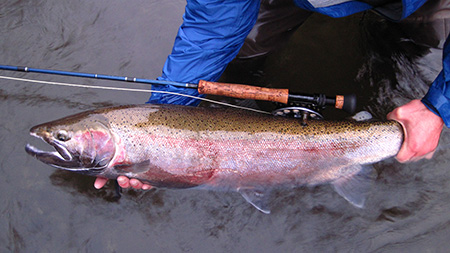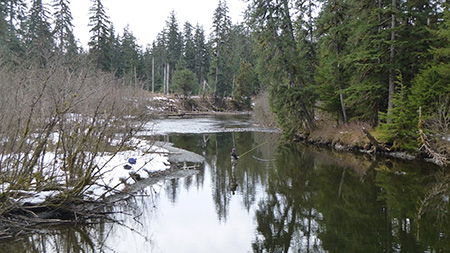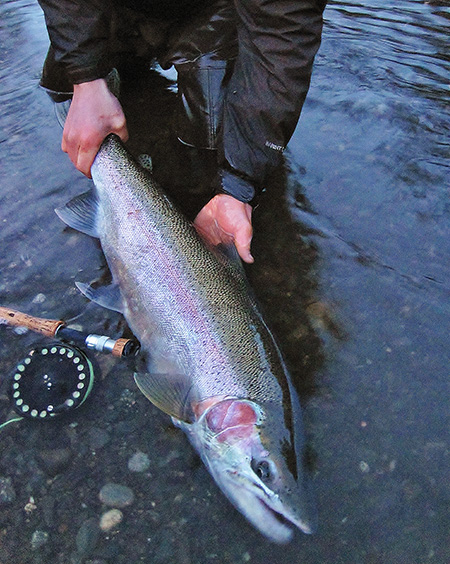The Situk River: An Alaska Steelhead Mecca

L
事実から話を始めよう。スティールヘッドは遡河性のニジマスだ。鮭と同じように淡水で孵化して育ち、そして産卵で生まれた川に回帰してくるまで、成長し成熟するために海洋へ出て行く。スティールヘッドの生活スタイルは複雑で、淡水と海水で異なる時間を過ごし、秋か春に生まれた(natal)川に戻ってくる。そして、数回産卵しても生き残ることができる。
Historically, you could find steelhead in streams up and down the west coast of the North America from Southern California to the Alaska Peninsula, but these days healthy populations of wild steelhead are harder to find. Most steelhead are now found in the northern portion of their range, in the more remote areas of British Columbia and Alaska.
歴史的には、南カルフォルニアからアラスカ半島までの北米西海岸の河川でスティールヘッドを見ることができた。しかし当時の野生のスティールヘッドの個体数を知ることは難しい。今日、ほとんどのスティールヘッドはB.C.とアラスカの僻地の北部で見られる。
So those are the facts, but anyone who has been lucky enough to tangle with a wild steelhead will likely describe them differently… They are smart and elusive fish, tucked into wild and inhospitable waters. Often, just finding a steelhead is an accomplishment in and of itself. But when presented with a well-placed lure or fly, steelhead can become voracious predators, striking, then fighting with a recklessness that turns the whole experience into something approaching chaos. The remarkable strength and ferocity of well hooked steelhead, tearing line wildly off the reel with freight train runs up and down the river, is an experience that is burned into the memory of a fortunate few.
これが事実だ。野生のスティールヘッドを論じることが十分可能な人たちはそれぞれ違うように述べている。スティールヘッドは自然の住みにくい川に押し込められた、利口で見つけにくい魚である。スティールヘッドを見つけ出すことは、それ自体(in and of itself)が1つの特技である。適したルアーかフライをキャストしたとき、スティールヘッダはすべての経験を何か混乱の中に戻し、向こう見ずなストライクとファイトを伴った貪欲な捕獲者になる。川を上へ下へ爆走する貨物列車のように、乱暴にラインをリールから引き出しながら、釣り鉤がガッチリかかったスティールヘッドの並外れた強靭さと獰猛さは幸運な小数の釣り人の記憶に焼き付いた経験となる。
With steelhead populations spread broadly across Southeast and Southcentral Alaska, there are many places to pursue these fish in our state. However, most of these populations are very small, consisting of 200 or fewer fish, which, when combined with the remoteness of many steelhead streams and the temperamental weather of the region to make steelhead fishing in Alaska challenging at best. But if you head north out from the inside waters of Southeast Alaska, tracking the wave-battered coastline past the shoulder of Mt. Fairweather and the glacial delta of the Alsek River, you’ll notice a change in topography. The sharp relief and dense forested slopes of the Southeast Alaska archipelago transitions to the broad coastal plain of the Yakutat forelands. This 50-mile stretch of coastline is patterned with pristine old growth spruce and hemlock forests that surround veins of rivers meandering from the mountains to the sea.
スティールヘッドはアラスカの南西部と中南部に広く拡がっているので、アラスカにはスティールヘッドが釣れる場所がたくさんある。しかしその個体数は非常に少なく200匹より少ない。多くのスティールヘッド川の僻地性とその地域の移り気げな天候のため、アラスカのスティールヘッド釣りは精々冒険的なものになっている。しかし、もし君がアラスカ南西部の内陸の川から北に向かったなら、地形の変化に気付くだろう。南西アラスカの諸島の急峻な起伏と密林帯の傾斜がYakutatの岬の広い海岸平野へと変化している。この50マイルの海岸線には自然のままの大木のトウヒとドクニンジン森林が分布していて、そこは山々から海への曲がりくねった川の静脈で被われている。
Among the numerous productive freshwater systems of the Yakutat forelands, the most renowned is the Situk River. Originating from two lakes (Situk Lake and Mountain Lake), the Situk flows approximately 18 miles, joining with several streams in a tidal estuary before exiting directly into the Gulf of Alaska. From its headwater lakes to the ocean, the Situk drops approximately 500 meters (nearly 1,650 feet) in elevation, creating slow meandering riffles and pools that provide excellent spawning and rearing habitat for anadromous and resident fish species. The stable, diverse, and productive aquatic habitats of the Situk watershed make it one of the most productive rivers of its size in Alaska. The Situk is home to significant populations of all five North American Pacific salmon species, Dolly Varden, rainbow trout, eulachon, also known as hooligan, and most remarkably, the largest known population of steelhead in Alaska.
Yakutat岬のたくさんの河川の中で、最も有名な川がSituk川だ。2つの湖(Situk湖とMountain湖)に始まり、約18マイル流れてアラスカ湾に流れ出すまでに、入り江でいくつかの小川と合流している。上流の湖から太平洋まで、Situk川は約500m(1650feet)の高低がある。ゆっくり曲がりくねった瀬とたまり場を形成していて、遡上魚と居付きの魚には素晴らしい産卵と生育の場になっている。Situk川の分水嶺の安定して、多様で、豊かな水域の生態はアラスカのこのサイズの川の中でもっとも豊かな川の1つとなっている。Situk川は5種類の北米太平洋鮭、ドリーバーデン、ニジマス、ユーラコン(北米ワカサギ)、そして最も際立つ、アラスカで最大の個体数として知られているスティールヘッドの母川である。

The acknowledged ecological and economic value of this fishery led to formalized assessment methods conducted by the Alaska Department of Fish and Game (ADF&G) beginning in 1988. The ADF&G weir on the lower Situk uses an underwater camera to count and sample post-spawn steelhead as they emigrate back out to sea. Over the past 10 years, an average of over 6,000 steelhead were counted at the weir, with a high count of over 15,000 occurring in 2006. The steelhead sport fishery on the Situk River is the largest in the region, on average over sixty percent of the steelhead caught in Southeast Alaska are caught on the Situk. While sport fish regulations in Southeast Alaska allow for the annual harvest of two steelhead, 36 inches or longer in length, the harvest of Situk steelhead has dropped to nearly zero in recent years as anglers have voluntarily adopted catch-and-release fishing practices.
ここの漁場の有名な生態的・経済的価値は1988年に始まるADF&G (Alaska Department of Fish and Game)によって、正式な調査が実施されている。Situk川下流域に設置されたADF&Gのヤナ(魚梁)では海へ戻る産卵後のスティールヘッドをカウントし抽出するために、水中カメラを使用している。過去10年以上、平均6,000匹以上のスティールヘッドがこのヤナでカウントされている。2006年に15,000匹の最大個体数があった。Situk川でのステールヘッド・スポーツ釣りはそのエリアで最大であり、アラスカ南西部で釣られるスティールヘッドの平均60%以上はSituk川である。南西部のスポーツ釣りの規制は36インチ以上で年2匹までで、釣人はキャッチ&リリースを自発的に実践しているが、最近の釣り人の釣果はほとんどゼロにまで落ちてきている。
But the Situk isn’t a great place to catch steelhead just because there are a lot of steelhead, it is also a uniquely accessible river. Daily jet service from Juneau or Anchorage makes it surprisingly easy to get to the remote coastal village of Yakutat, and several lodges and bed and breakfast operations cater specifically to steelhead anglers each spring. Once you’ve made it to Yakutat, the relatively small size of the Situk and miles of trails along the upper and lower sections of river allow it to be fished very effectively by wading anglers, especially those willing to put in some miles. For those who prefer fishing from a boat, the U.S. Forest Service (USFS) maintained launch ramp at 9-Mile bridge is the starting point for a 13-mile float down the river to the lower Situk landing pull out. This full day float gives anglers access to miles and miles of premium fishable waters, including stretches difficult to reach on foot. Many anglers choose to utilize the services of local guides from lodges or independent operations, this is great way to get a crash course on Situk steelhead but is certainly not necessary to find fish.
Situk川にはたくさんのスティールヘッドがいるので良い釣り場ではないが、アクセスがユニークな川だ。ジュノーかアンカレッジから、毎日ジェット便があり、Yakutatの僻地の浜辺の村へ驚くほど簡単に行くことができる。村にはいくつかのロッジとB&Bは、毎春スティールヘッド釣り客のために食事を提供している。君がYakutatに釣りに来ると、Situk川の比較的小さいサイズと上・下流域にある川添いのトレイルのおかげで、ウェーディングの釣人には効果的に釣りができる。特に、ボートで釣りたい釣人には、USFS(U.S. Forest Service)が管理する9マイル橋のボート搬入場所が下流域のボート搬出場所までの13マイルの川下りの出発点になる。一日川下りの釣りは何マイルにも渡って徒歩で到達困難な最高の釣り場を提供する。多くの釣り人はロッジで地元のガイドを使うか、自分でボートを操作する。後者はSituk川の特訓コースにはイイが、魚を見つけるために必ずしも必要でない。
The Situk is also an ideal destination for the DIY angler, many of whom prefer to camp near the river to maximize time on the water. The USFS tent platforms at 9-mile bridge are perfect for getting you out of the moss and under some cover, but there are numerous places for anglers on foot or floating the river to camp as the Situk falls completely within the Tongass National Forest. There are also three USFS public use cabins in the Situk River watershed, two of which are located about 2 miles downstream from 9-mile bridge, which can be accessed by boat, foot, or plane. The third cabin is on Situk Lake which is about a 3.5-mile hike from the Situk Lake trailhead, possibly longer depending on the snow conditions of the roads in early spring. These popular cabins book up well in advance of steelhead season but can provide welcomed shelter and warmth from the unforgiving weather of the spring and fall seasons in Southeast Alaska.,
また、できるだけ長く川で過ごせるように川近くでキャンプしたいDIY釣人にはSituk川は理想的な場所だ。9マイル橋のUSFS公設テント場は苔の地面から逃れて天井カバーのある場所として理想的だ。Situk川にはTongass国立森林帯の中を下ると、陸釣りやボートの釣人がキャンプするのに適したたくさんの場所がある。Situk川には3つの公設のキャビン(小屋)があり、その2つは9マイル橋から2マイル下流にあり、徒歩、ボート、そして飛行機を使ってアクセス可能だ。最後のキャビンはSituk湖トレイルから3.5マイル歩いたSituk湖にある。そこは早春の雪の中では、もっと時間が掛かるかもしれない。これらのキャビンはスティールヘッドシーズンの前に予約で一杯になるが、南西アラスカの春と秋の過酷な天候に対して快適なシェルターと暖かさを提供してくれる。

Having spent nearly 15 seasons on the Situk, I am most struck by the connection many anglers have developed to this river and its fish. It’s not uncommon to strike up a gravel bar conversation with someone who has been fishing the Situk for 30 years or more. It is a place where parents bring their kids and grown-ups bring their parents. These connections are fostered by the uncommon opportunities the Yakutat area and the Situk provide to all anglers. A chance to step away from the hustle of daily life, to climb into waders in the predawn darkness, to ready the boat or strategize on which section of the river to hike, and to go find a fish that you will remember forever.
私は、Situk川で約15シーズン過ごしてきてたくさんの釣り人が川と魚を育てているという繋がりに気付いた。Situk川で30年間以上釣りをしてきている人に釣り場で話し掛ける(strike up a conversation)ことは、珍しいことではない。そこは両親が子供たちを連れてきて、成長した成人たちが両親を連れてくる場所である。この繋がりはYakutatの地域とSituk川がすべての釣り人に与える稀な機会によって育まれている。日々の喧噪から離れ、夜明け前の暗闇の中で急いでウェーダを着て(climb into wader)、ボートの準備や歩く川の区間を考え、魚影を見つけに行くために。
The Situk and its fish provide this opportunity because complex biological systems of forest, river, and ocean come together to produce and sustain a population of steelhead that is as wild and healthy as the ecosystem around them. To protect this opportunity anglers must be stewards of the fish and of the place, we must prioritize careful conservation of the steelhead population and of the watershed that supports it. During my time on the Situk I’ve seen the effects of thousands of anglers visiting this river each year, littered trails and campsites, stream bank erosion, giant tangles of fishing line and gear in river. These impacts combine to degrade the health of the ecosystem itself, as well as the experience anglers have on the river. We must also remember that this area is the ancestral home of the local Native community and that the Situk River literally provides the food locals depend on to live.
Situk川とその魚がその機会を与えている。というのは、森林、川、海洋からなる複雑な生物系が一緒になって周辺の生態系として、自然で健全なスティールヘッドの個体数を生み・維持している。この環境を守るために、釣人は魚と場所の執事であらねばならない。我々はスティールヘッドの数とそのための水系を注意深く維持することを優先せねばならない。Situk川で私は長い間、毎年訪れるたくさんの釣り人の影響を見てきた。ゴミが散らかったトレイルとキャンプサイド、川岸の浸食、川の絡んだ釣糸、そして釣り道具のゴミだ。これらの影響により、生態系それ自身の健全性を悪化させることになる。釣人が川で味わう経験と同様に。また、この地域は原住民が代々受け継いできた土地(故郷)でもあり、Situk川は文字道理、原住民が生活に必要な食べ物を提供していることを理解しておかなければならない。
So, when you do finally visit the Situk I hope you’ll bring feelings of respect and responsibility to match the excitement we all feel when the opportunity to catch a wild steelhead draws near. Remember to tread lightly, the gravel you’re stepping on may hold the eggs of the fish you’ll hope to catch in a few years. Remember to pack out what you pack in, to skip a few grip and grin pictures and keep ‘em wet as much as you can, to use only single hooks, and never use bait. These are a few of the easy things all visitors to the Situk can do to help ensure we can all continue to connect to this wild place and these wild fish.
それで、Situk川にやってきて、野生のスティールヘッドを釣る機会があるなときは、皆が感じる興奮に見合う尊敬と責任感を持ってくれることを、私は期待している。そっと歩く(tread lightly)ことを忘れるな。君が立っている砂利は数年間君が願っていた魚の卵を抱えているかも知れない。持ち込んだ物を、持ち帰ることを忘れるな。
Matt Catterson is the Division of Sport Fish Management Biologist for the Yakutat area. Having spent years pursuing steelhead recreationally and professionally across Northern Southeast Alaska, he is happy to chat with anyone considering a steelhead trip to the Yakutat Area or beyond.
Matt CattersonはYakutatのSport Fish管理局の生物学者で、南西アラスカの北部で、スティールヘッドを娯楽と仕事の両面で探求してきた。Yakutat地区か、それ以外へのスティールヘッド旅行を考えている人はお気軽に連絡を。
0 件のコメント:
コメントを投稿